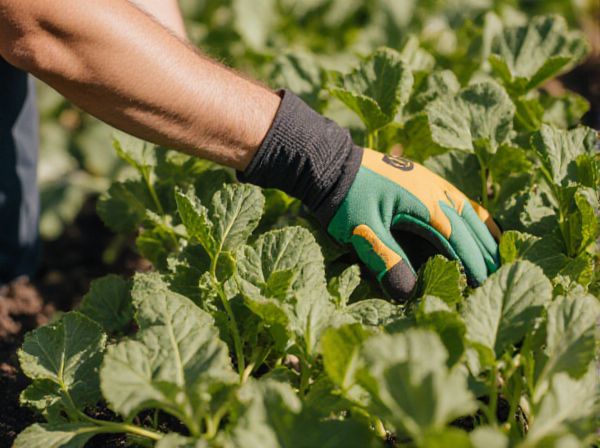
Crop Rotation Harvest vs Monoculture Harvest Illustration
Crop rotation harvest improves soil fertility and reduces pest buildup by alternating different crops each season, leading to sustainable yields and long-term farm health. Monoculture harvest involves growing the same crop continuously, which can deplete soil nutrients and increase vulnerability to pests and diseases. Implementing crop rotation enhances biodiversity and resilience, making it a superior practice compared to monoculture harvesting.
Table of Comparison
| Aspect | Crop Rotation Harvest | Monoculture Harvest |
|---|---|---|
| Soil Fertility | Improves soil nutrients, reduces depletion | Leads to nutrient depletion and soil degradation |
| Pest and Disease Control | Reduces pest buildup through diverse crops | Increases pest and disease vulnerability |
| Yield Stability | Provides consistent yields over time | Yields may decline with repeated crops |
| Environmental Impact | Promotes sustainability and biodiversity | High environmental stress and erosion risks |
| Economic Returns | Potentially higher due to diversified crops | Can be higher short-term but risks long-term loss |
Understanding Crop Rotation Harvest
Crop rotation harvest enhances soil fertility by alternating crops, reducing pest buildup and increasing yield stability compared to monoculture harvest. This sustainable practice minimizes nutrient depletion and improves soil structure, promoting long-term agricultural productivity. Understanding crop rotation harvest enables farmers to optimize resource use and reduce dependency on chemical inputs.
Overview of Monoculture Harvest
Monoculture harvest involves cultivating a single crop species in a specific area, leading to simplified management but increased vulnerability to pests and soil depletion. This practice often results in high short-term yields due to uniform planting and harvesting schedules but can degrade soil health over time. Reliance on monoculture harvest necessitates increased chemical inputs such as fertilizers and pesticides to maintain productivity.
Comparing Yield Outcomes
Crop rotation harvests generally deliver higher and more sustainable yields compared to monoculture harvests by improving soil fertility and reducing pest cycles. Studies show that crop rotation can increase yield by 10-25%, enhancing nutrient availability and minimizing soil depletion. Monoculture harvests often face declining productivity over time due to increased disease pressure and nutrient exhaustion.
Soil Health and Nutrient Management
Crop rotation harvest enhances soil health by reducing nutrient depletion and disrupting pest cycles, promoting balanced nutrient availability and improved soil structure. In contrast, monoculture harvest often leads to soil nutrient imbalances, increased vulnerability to pests, and greater reliance on synthetic fertilizers. Sustainable nutrient management practices in crop rotation contribute to long-term soil fertility and reduced environmental impact compared to monoculture systems.
Pest and Disease Resistance Factors
Crop rotation harvest improves pest and disease resistance by disrupting the life cycles of pests and pathogens, reducing their population buildup compared to monoculture harvest systems. Diverse crops in rotation enhance soil health and microbial diversity, strengthening plant immunity naturally. Monoculture harvests increase vulnerability to outbreaks due to repeated planting of the same species, which allows pests and diseases to adapt and thrive more easily.
Environmental Impact Assessment
Crop rotation harvest significantly reduces soil depletion and pest accumulation compared to monoculture harvest, promoting healthier soil biodiversity and structure. Environmental impact assessments reveal that crop rotation lowers the need for chemical fertilizers and pesticides, decreasing water pollution and greenhouse gas emissions. Monoculture harvest practices often lead to increased soil erosion and nutrient runoff, intensifying environmental degradation and reducing long-term agricultural sustainability.
Long-Term Sustainability Considerations
Crop rotation harvest enhances soil fertility and reduces pest buildup by alternating different crops seasonally, promoting long-term agricultural sustainability. Monoculture harvest often leads to soil nutrient depletion and increased vulnerability to pests and diseases, necessitating higher chemical inputs. Sustainable farming practices prioritize crop rotation to maintain ecosystem balance and improve yield stability over time.
Economic Efficiency and Profitability
Crop rotation harvest enhances economic efficiency by improving soil fertility and reducing pest outbreaks, leading to higher yields and lower input costs compared to monoculture harvest. Monoculture harvest often demands increased expenditure on fertilizers and pesticides, which can erode profit margins despite initial higher yields. Long-term profitability favors crop rotation systems due to sustainable resource use and resilient production cycles.
Best Practices for Crop Rotation Harvest
Crop rotation harvest maximizes soil fertility and reduces pest buildup by alternating crops with complementary nutrient needs, unlike monoculture harvest which depletes soil nutrients and increases vulnerability to pests. Best practices for crop rotation harvest include selecting diverse crop species, timing planting based on soil health indicators, and incorporating legumes to naturally boost nitrogen levels. Implementing these strategies enhances yield stability, soil structure, and long-term agricultural sustainability.
Challenges and Limitations of Monoculture Harvest
Monoculture harvests face significant challenges such as increased vulnerability to pests and diseases due to the lack of biodiversity, leading to higher dependency on chemical pesticides. Soil degradation and nutrient depletion are common limitations, as continuous planting of the same crop reduces soil fertility over time. These issues result in decreased long-term sustainability and productivity compared to crop rotation systems, which enhance soil health and ecosystem resilience.
Crop Rotation Harvest vs Monoculture Harvest Infographic

 gardendif.com
gardendif.com